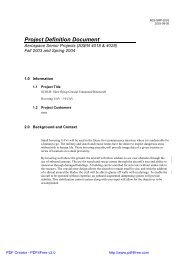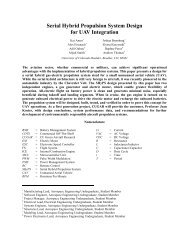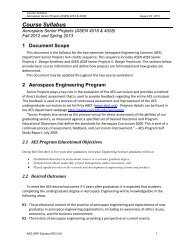PFR - Aerospace Engineering Sciences Senior Design Projects ...
PFR - Aerospace Engineering Sciences Senior Design Projects ...
PFR - Aerospace Engineering Sciences Senior Design Projects ...
You also want an ePaper? Increase the reach of your titles
YUMPU automatically turns print PDFs into web optimized ePapers that Google loves.
Project Final Report – CUDBF April 30 th , 2009<br />
ASEN 4028: <strong>Aerospace</strong> <strong>Senior</strong> <strong>Projects</strong><br />
Figure 63: Landing Gear Placement<br />
8.4.6 Longitudinal and Lateral Ground Stability:<br />
Longitudinal stability is determined by the angle from the main gear to the aircraft center of<br />
gravity as seen in Figure 64.<br />
Figure 64: Longitudinal Stability<br />
In order for stability to be assured, this angle must not be less than 15°, or else the plane will<br />
tend to nose into the ground, prompting a propeller strike on landing or even during taxi. The<br />
aircraft may also tip backwards under the same conditions, rendering ground control impossible.<br />
With the current landing gear placement, the angle for the Buff-2 Bomber is 20°, giving the<br />
vehicle ample stability in the longitudinal direction.<br />
Lateral stability depends on the angle ψ which is seen in Figure 65. In order to be statically<br />
stable (i.e. when not in motion) the angle ψ must be under 90°. Because the Buff-2 Bomber has<br />
a lateral stability angle of 85° under the worst loading case (two rockets on one wing), the<br />
aircraft achieves lateral stability in all circumstances (lateral stability was calculated using AAA<br />
[27] ).<br />
90
















